Universal Themes
The universal remote control, love it or hate it, made our lives just a little bit simpler starting in the ‘80s. It's not as good as it could be. That's OK.
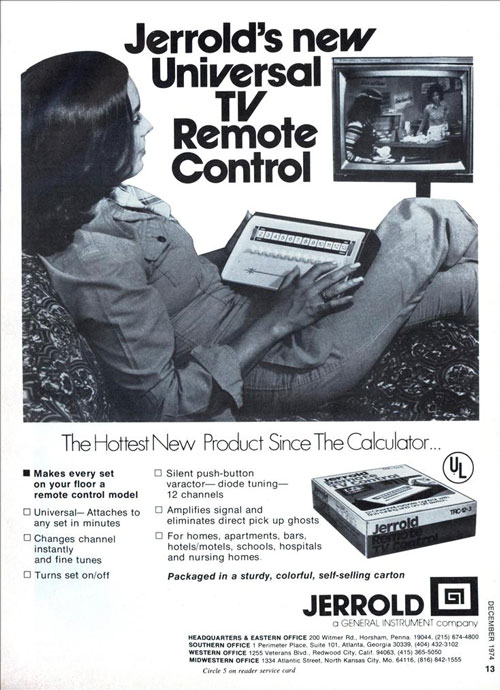
The hottest new product since the calculator, apparently. (via Modern Mechanix)
Five important evolutions in remote control design before they went universal
- In 1938, Philco released what is widely considered the first wireless remote control, the “Mystery Control” device, a radio remote control which uses an analog dial that is about the size of a telephone.
- Zenith’s Flash-Matic remote control, an early innovation released in the 1950s, looked like a light gun because, basically, it was. Designed by Eugene J. Polley, it offered very simple functionality, but it had some technical issues—most notably, the tuner was affected by sunlight. It was the first wireless remote released for television.
- Zenith was also responsible for the first wireless remote control that relied on “ultrasonic” commands—in other words, sounds that you can’t hear. It was the most common type of remote for roughly two decades, but as the New York Times notes, this approach was imperfect due to the Doppler effect—the way that sound frequencies are affected by motion.
- One noteworthy innovator on the remote front, per Slate, was Bang & Olufsen, whose remote designs were perhaps simpler and more intuitive than other designs of the early era. “In general, Bang & Olufsen’s development of remote controls can be summed up in a simple concept: Intuitive use,” explains enthusiast site BeoWorld. “It is important to be able to adjust sound and picture from wherever you may be in the home.”
- The term “universal remote” was first bandied about in the 1970s, in reference to a device produced by Jerrold, which provided wired remote controls for cable boxes. The devices ware huge, and often quite imposing, but they worked on basically any TV set because of the set-top box. “As Jerrold’s remotes became more powerful, moreover, they only became larger,” author Caetlin Benson-Allott explained in the 2015 book Remote Control. “Once Jerrold added a UHF mode to its cable remote, for instance, the device reached the size of a full-scale computer keyboard.”
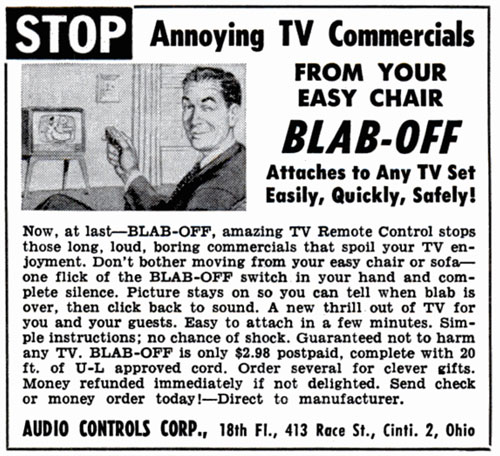
(via Popular Mechanics)
The prototype of the universal remote was the TV muting device
Early televisions had a lot in common, but early on, one thing they did not have was a remote control. This proved a problem in many cases, as early advertisers had yet to figure out that consumers were turned off by loud ads.
This problem led to an array of similar solutions that were designed to do one thing: Mute the TV on command.
Gerald Shirley, developer for the electronics firm Televex who was better known for his work with audio equipment, claims to have been the first to create a device of this nature—in a letter to the editor printed in The New York Times in 1999, setting the time frame to around 1950. A 1952 article in High Fidelity briefly touched on Shirley’s “Com-muter.”
Whether or not Shirley was the first inventor, it was ultimately a guy named Howard Manischewitz—yes, like the kosher food company, and yes, he was involved in the company—who made the most common device of this nature, the Blab-Off. In an article for Early Television, Manischewitz’s daughter Laura Alpert recalled how early commercials were so loud that he was inspired to build a device that cut off the audio cables whenever a switch was pressed—the result of a challenge he took to come up with a fix in less than 10 minutes.
He succeeded, and in 1952, he was looking to sell a set of easy-to-install wires that would effectively allow the average TV owner to shut the device up for a second. Blab-Off was born—under a pseudonym, of course, to ensure that Manischewitz’s last name didn’t get him in trouble. As “Bob Grant,” he got an ad agency involved and a budget to start mass-manufacturing the devices.
Coming at a time when the television itself was still relatively novel, it wasn’t long before his device had generated a mixture of controversy and broad use. Newspapers, magazines, and TV networks would quickly reject ad buys involving the devices, only to have some big-name backer show themselves anyway. On his TV show, for example, news commentator Walter Winchell offered up a free ad for the device:
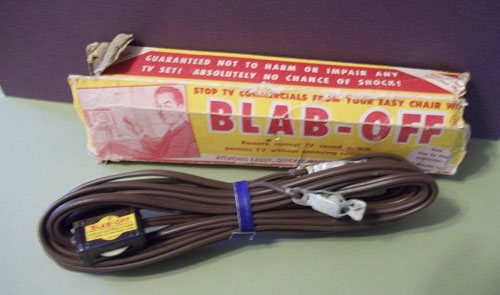
(via Discuts)
“The most terrifying gadget in television for TV set owners will soon be announced, and sells at $2.98,” Winchell said, according to Alpern. “One flip of your finger from your easy chair in your parlor will turn out all commercials and commentators that annoy you. It is called Blab-Off, named after, I guess, the commentators.”
Similarly, Reader’s Digest raved about the device and gave it room in its hallowed pages—something that drove massive sales for the relatively inexpensive device.
It was effectively a single-function remote control (even if there was a wire involved; many early remotes had one), and it worked on basically any TV, so it was universal. But it took a bit of evolution before we had true universal remote ubiquity.
1980
The year that Paul Hrivnak, an engineer with ties to the amateur radio industry, first came up with the infrared remote control. Hrivnak’s discovery, which was sold under the Philips name but manufactured by his then-company Viewstar, was a part of a cable converter that had the Philips name on it. Hrivnak’s use of infrared became hugely influential—helping the cable box sell numerous units and eventually leading to televisions supporting the technology. Bang & Olufsen was one of the earliest firms to do so.
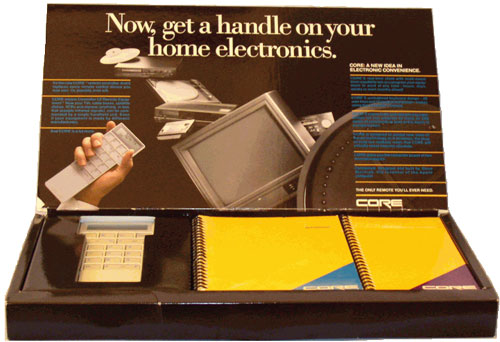
The CL9 Core, designed by Steve Wozniak: Not as easy to use as the Apple II. (via K-Tronics)
Why the universal remote isn’t really all that ambitious in practice
A decade after the release of the Apple II, Steve Wozniak, still somewhat fresh off his experience of paying for the US Festival, was ready for a new commercial adventure, and it couldn’t look less like Steve Jobs’ NeXT if he tried. Woz was one of the earliest innovators on the universal remote control front.
His firm, CL9 (standing for “Cloud 9”), implies a firm focused on moonshots of sorts, and the moonshot Woz focused on was a programmable infrared remote control, which he called the CORE. In a 1985 BusinessWeek article, Wozniak suggested that while the project had a larger budget than the Apple I did, it had a similar ethos and thought process. (One thing it didn’t have was Apple’s design capabilities: Jobs forbade Frog Design, Apple’s longtime design firm of choice, from working with Wozniak’s firm.) He was putting in incredibly long days.
“I wanted a personal computer, so I designed the Apple. I live in a house with lots of televisions and VCRs, and I wanted a single unit to control them all,” he said.
But while Wozniak’s goal was noble, it turned out that the electronics firms that Apple had upstaged in the ’70s were going to win this round. Wozniak’s device—leveraging the infrared technology that Paul Hrivnak had introduced as a viable concept for television just a few years prior—was hackable and programmable, and fairly technical, closer to a graphing calculator than a remote control. (You don’t want highly technical in a remote control, unless you’re a tinkerer.)
One thing it wasn’t, however, was first. In 1984, the audio company Acoustic Research had released its Model SRC-1, which offered to do for stereo equipment what Wozniak was promising to do for the TV. But instead of focusing on programmability, it simplified its command set, ensuring that the device would work with any piece of stereo equipment. A New York Times review raved about the device:
To gain this degree of compatibility, Acoustic Research had to sacrifice certain functions, such as the ability to change radio stations by remote control or command a cassette deck to switch from playback to recording or vice versa. Even so, the Acoustic Research Model SRC-1 wireless control, priced at $160, performs a variety of useful tasks. It turns the system on and off from across the room, adjusts the volume at either a fast or slow rate of change, shifts the channel balance, and can instantly lower the volume by 20 decibels—a handy trick when the phone rings. The control also has what’s known as a sleep-switch on dock radios; it can be set to shut off the system after 30 minutes.
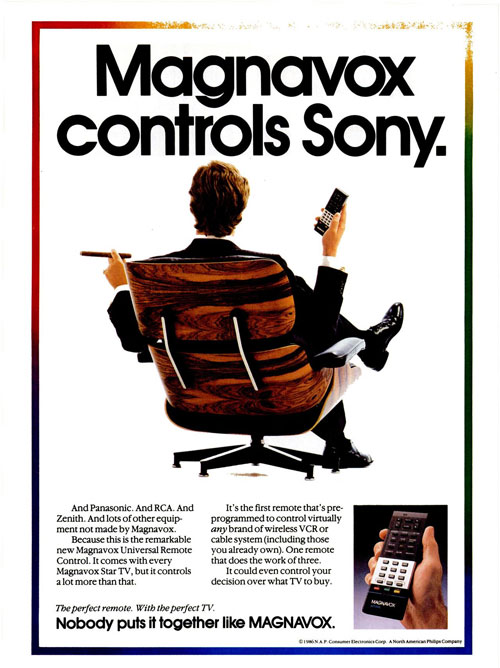
Magnavox controls Sony. (via Popular Mechanics)
This strategy, with some changes, ultimately proved the winning one for the living room, and was the one adopted by numerous television companies, most notably by Philips on its Magnavox devices. First released in 1985, with a patent filed the same year and granted in 1988, the remotes were the first to support multiple types of electronics on a single remote.
An early patent for a “reconfigurable remote control,” granted to General Electric in 1986 and predating the Philips patent, speaks to the goals of the universal remote at this time:
“A consumer may have separate remote control transmitters for a television, a cable converter, video cassette recorder, and a video disc player, for example. In such a case, it is confusing to know which transmitter to pick up to control which product,” the patent filing states. “Moreover, carrying around four different remote control transmitters spoils the convenience of the remote control feature. It is therefore desirable to provide a single remote control transmitter for controlling each of the several products.”
Wozniak’s approach with the CORE tried to do this, but focused perhaps too much on the edge cases. (The fact that Jobs screwed him out of working with a favored industrial design firm probably didn’t help.)
The result is that our programmable remotes look much more like the GE patent than they do Wozniak’s approach. Philips, which owned the Magnavox brand, took steps toward usability with its approach, notably filing a patent for auto-detecting a specific device.
Perhaps the result, with its mess of buttons, reliance on confusing remote codes, and tendency to get caught up by edge cases, isn’t perfect, but it’s what the average person ended up getting.
“VCR Plus controls both the cable box and the VCR. Now, if you’re away from home, you can tape shows on different cable channels. VCR Plus changes the channel for you. You just enter one number for each show.”
— Louise J. Wannier, the vice president of marketing and business development for Gemstar, explaining to the Los Angeles Times in 1990 the benefit of the VCR Plus system. The concept—which I would argue is probably the closest we got to truly programmable universal remotes used by a mass audience—was designed to automatically program a VCR to record a show automatically simply by typing in a code attached to a TV schedule. The L.A. Times wrote about the concept because it was adding the codes to its TV section—a common addition to newspapers during the ’90s.
The modern-day universal remote has some long, roundabout roots that go back to the days of the Blab-Off, a gimmick that was a great example of the public taking on advertisers with technology. (Fun fact: The Blab-Off actually led to TV ads getting quieter in the 1950s, because it made the ad industry nervous.)
It only makes sense that there’s a direct descendant of the Blab-Off that’s still sold today. That device, the TV-B-Gone, is essentially a single-function universal remote that does one thing: It allows users to turn off TV sets in public places.
The concept, invented by early virtual reality figure Mitch Altman in the ’90s, is designed to be able to turn off any TV set in the distance—in some cases so powerfully that it turns off multiple sets at once.
The idea, of course, is to remove unwanted distractions, especially when nobody is around to actually turn off the sets.
“The way I see it, it’s only fair,” Altman told Wired of the concept in 2009. “If a TV shines light at me, I’ll shine a light at it. And if it stops shining light at me, I’ll stop shining light at it.”
As universal remotes go, you will find one no simpler and no more effective.
:format(jpeg)/2017/05/tedium052517.gif)
/2017/05/tedium052517.gif)

/uploads/ernie_crop.jpg)